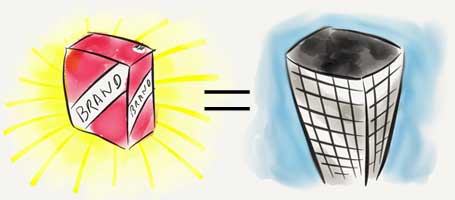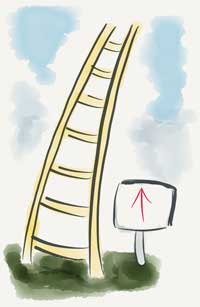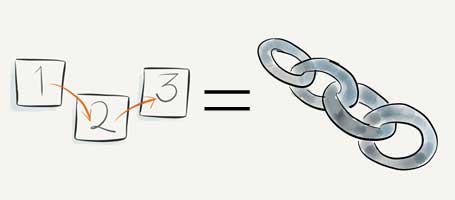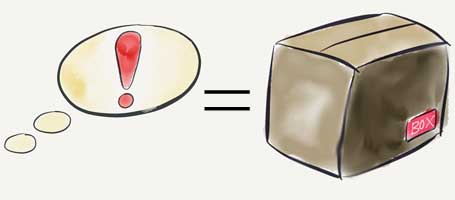Twenty business metaphors and what they mean
Metaphors are ways of understanding one thing in terms of another. They are a bridge from the close and familiar to the distant and strange, explaining the unknown in terms of the known.
Many of us first become aware of metaphors (and similes) by studying poetry (‘Shall I compare thee to a summer’s day?’). But they’re not just fancy figures of speech that decorate or dress up what we ‘really mean’. They pervade our everyday language, and shape the way we think. Metaphors are shared ways of seeing the world.
Metaphors are, by nature, imperfect. Like spotlights, they illuminate some things while leaving others in the dark. This means they sometimes outlive their usefulness, and have to be dropped or replaced. However, some are incredibly durable, and may even become the ‘proper’ way of talking about something (see ‘Time=money’ below).
Metaphors are valuable tools in business, particularly when people need to communicate complex, dry ideas. Because metaphors nearly always depend on familiar physical objects as their vehicles, they make abstract concepts more concrete and sensory-rich. (For example, look back at the use of ‘bridge’, ‘tool’ and ‘spotlight’ in this post so far.)
This post looks at a few metaphors used in business communication. Some are clichéd, and others may be new to you. Some are fresh and vivid, while some are so familiar and ingrained that we’re hardly aware that they are metaphors. And they all have a range of conscious and unconscious connotations that may or may not be useful, which are worth considering before you use them.
Time = money
 This idea is so utterly pervasive, in life as well as business, that it scarcely registers as a metaphor. Yet before the Industrial Revolution, when people started to be paid for the hours they worked, nobody would have used phrases like ‘saving time’, ‘spending time’, ‘wasting time’, ‘affording the time’, ‘running out of time’, ‘living on borrowed time’ or anything else that characterises time as a fungible resource.
This idea is so utterly pervasive, in life as well as business, that it scarcely registers as a metaphor. Yet before the Industrial Revolution, when people started to be paid for the hours they worked, nobody would have used phrases like ‘saving time’, ‘spending time’, ‘wasting time’, ‘affording the time’, ‘running out of time’, ‘living on borrowed time’ or anything else that characterises time as a fungible resource.
Living, as we do, under the tyranny of the clock, it’s hard to imagine what life was like without this metaphor. Perhaps times of day were more like labels that were applied to certain events, when they had to be. Otherwise, time must have slipped by without needing to be counted, measured or exchange, existing only in our heads and the natural cycles of the world.
Organisations = machines
This is another product of the Industrial Revolution, when businesses were characterised like the machines around which they were built. Applying the concept of mechanisation to human work led to things like organisational diagrams (=blueprints), departments (=components), job specifications (=functions) and so on.
All these concepts were productive in their way, but they obscured the reality of an organisation as a group of people. Unlike uniform components, people have very different abilities and aptitudes. And unlike machines, they can’t be turned up, dismantled or tinkered with at will.
Organisations = people
Mechanistic management ideas certainly haven’t gone away, but these days forward-thinking organisations might complement them with the idea of the business as a person, with a ‘personality’ (i.e. company culture) and the capacity to ‘learn’.
This adds a welcome dimension of humanity. However, thinking of an organisation as a single person also obscures its plurality. While we can speak of a person having ‘values’ and ‘beliefs’, a group can only really have shared interests at best. When a large company claims to have a unified ‘culture’ or ‘philosophy’, it’s really articulating managers’ imposed ideas, not speaking on behalf of everyone inside the firm.
Products = solutions
I’ve explored the origins and popularity of this word here. To the extent that it is a metaphor, it suggests that business situations are problems or puzzles to which a particular product or service is the answer. That’s probably positive, although it arguably implies that the customer lacks intelligence for not being able to work it out themselves.
More distantly, there’s also the chemical meaning of ‘solution’, which is one substance dissolved in another to form a single-phase mixture. While this connotation is probably perceived only faintly (if at all), it is quite apposite: the problem is the solute and the product is the solvent, and they combine perfectly to form the solution.
Products = clothing
 This metaphor draws a distinction between ‘off the shelf’ products or services, made to a predetermined specification, and those that are ‘tailored’, ‘bespoke’ or ‘made to measure’ to meet the needs of a particular customer.
This metaphor draws a distinction between ‘off the shelf’ products or services, made to a predetermined specification, and those that are ‘tailored’, ‘bespoke’ or ‘made to measure’ to meet the needs of a particular customer.
‘Off the shelf’ is often used perjoratively by high-end service providers, but off-the-shelf goods are usually cheap and convenient, which people may value and therefore regard positively.
Conversely, ‘tailored’ and particularly ‘bespoke’ carry connotations of Savile Row expense and social superiority. If you’re selling to an inverted snob who wouldn’t buy a tailored suit even if they could afford it, they may be turned off by this highfalutin sense of ‘giving oneself airs’.
Products = tools
We describe so many things as ‘tools’ that we’re hardly aware of the true meaning of the word. A tool is handy, practical and perfectly suited to a particular job. However, its specificity is its limitation as well as its strength. A hammer is perfect for knocking in nails, but useless for measuring. So the ‘tool’ metaphor conveys utility without flexibility.
Products = buildings
 We often speak of ‘building’ products with a particular ‘architecture’, particularly in technology sectors. ‘Platform’ has become very widely used for software applications, particularly those that enable the user to accomplish a complicated task (e.g. ‘a platform for content management’). ‘Platform’’s associations of support and solidity are ideal, but the metaphor may be overstretched by phrases such as ‘flexible platform’, which doesn’t sound like something you’d want to stand on.
We often speak of ‘building’ products with a particular ‘architecture’, particularly in technology sectors. ‘Platform’ has become very widely used for software applications, particularly those that enable the user to accomplish a complicated task (e.g. ‘a platform for content management’). ‘Platform’’s associations of support and solidity are ideal, but the metaphor may be overstretched by phrases such as ‘flexible platform’, which doesn’t sound like something you’d want to stand on.
‘Foundation’ is also used, and has a positive sense of firmness and strength. However, once laid, a foundation is quite literally ‘set in stone’, grounded beneath the structure it supports. While reassuring, this permanence might subconsciously communicate limitation or constraint.
Products = organisms
 This metaphor is expressed in phrases like ‘product lifecycle’, ‘product families’, ‘next generation’ and so on. It draws a parallel between the evolution of living things and the way products are developed. This nicely captures the idea of gradual improvement through iteration, as well as the way in which products are ‘born’ (=introduced) and eventually die (=withdrawn) – always assuming they’re not killed off by the forces of ‘natural selection’ in the market.
This metaphor is expressed in phrases like ‘product lifecycle’, ‘product families’, ‘next generation’ and so on. It draws a parallel between the evolution of living things and the way products are developed. This nicely captures the idea of gradual improvement through iteration, as well as the way in which products are ‘born’ (=introduced) and eventually die (=withdrawn) – always assuming they’re not killed off by the forces of ‘natural selection’ in the market.
One drawback of this metaphor might be the way it downplays human agency. Products and services don’t actually have an independent life, nor will they evolve independently. They are the result of our own ideas and decisions – reflections of ourselves, for better or worse.
Progress = elevation
This idea encompasses such well-worn phrases as ‘taking it to the next level’ and ‘onwards and upwards’. If we visualise this metaphor consciously at all, we might think of a lift going to the next floor, or perhaps someone ascending a flight of stairs. While ‘up’ is usually associated with ‘more’ and ‘better’ (think of growing up as a child, or line graphs), not everyone likes heights.
Careers = ladders
 Thinking of careers as ladders embodies the same ‘up is good’ idea as ‘progress = elevation’. The higher up the ladder you go, the more you can see – and the more you can ‘look down on’ those below you.
Thinking of careers as ladders embodies the same ‘up is good’ idea as ‘progress = elevation’. The higher up the ladder you go, the more you can see – and the more you can ‘look down on’ those below you.
Since ladders are one-person tools, there’s also an implication that you’re making this climb alone. So what will happen if others do try and join you? Will the ladder break, or fall?
More to the point, what if you reach the top and discover that your ladder was leaning against the wrong wall? Jumping across to another ladder is dangerous, so you might have to go all the way back down and start again.
A more useful metaphor in this context might be ‘careers = paths’. Paths fork, implying choice. Overtaking, or being overtaken, is no big deal. You can step off the path for a while, if you like – there might even be a bench to sit on. And while some might feel the need to ‘get ahead’, it’s clear that the most important thing is not how far you go, but whether you’ve chosen the right path for your destination.
Work = sport
‘Performance’ has different connotations depending on which sense is evoked. In engineering, it means optimising a machine to get the most from a resource, such as fuel. In sport, it means achieving potential and perhaps victory, while in the arts it means entertaining an audience. The word can have both an individual and a group dimension.
The concept of ‘high’ or ‘peak’ performance is often reinforced with images of athletics, football, motoring and so on. Without resorting to gender stereotypes, it’s worth considering whether a proportion of the audience might be turned off by these associations.
We also use phrases like ‘get up to speed’, which picture a situation as a race or timed event in which it is possible to be ‘left behind’. It generates a sense of urgency while also imposing all the associations of such a ‘zero-sum game’ – in other words, if I win, you’ve lost, and there are no alternative routes to choose. Related metaphors include ‘level playing field’, ‘final lap’ and so on.
Strategy = chess
This is perhaps one of the most apposite of all business metaphors, and has duly spawned a hundred book covers. It accommodates ideas of planning, hierarchy, control, resource allocation, gradual development, competition and more, and brings us phrases like ‘opening gambit’, ‘good (or bad) move’, ‘endgame’ and so on.
Like the idea of competition as a race, the only limitation of this metaphor is its boundedness. Sometimes, the best strategy is not to play well within the rules (IBM), but to change the rules themselves (Apple). By the same token, your greatest threat might not be your familiar, obvious opponent, but some outside force you don’t notice because your head is down over your pieces.
Processes = journeys
Almost any sequence of events can be considered as a journey, from the whole of life (Lloyds TSB’s ‘For the journey’) to the process of buying a product. Phrases that allude to this metaphor include ‘the way ahead’, ‘planning a route’, ‘on the horizon’ and ‘wrong turning’, plus related concepts like ‘milestones’, ‘gates’ and so on.
However, a journey is planned in advance, with a defined starting point, route and destination. ‘Journey’ implies intention. That may not be the best way to conceive of processes that may actually be much more haphazard and emergent, such as choosing a product or indeed living our lives.
 Processes = chains
Processes = chains
As in ‘supply chain’, ‘chain of command’ and so on. Positive connotations are power and reliability, coupled with the warning that ‘a chain is only as strong as its weakest link’.
On the downside, ‘chain’ inevitably evokes metallic coldness, slavery and captivity (although that might be a turn-on for some).
Processes = cycles
Phrases like ‘sales cycle’ helps us to picture a certain sequence of events as a circular process. We might capture the sequence as a diagram with stages linked in a loop. The analogy is with a round trip, or perhaps a lap around a sports circuit.
I personally dislike such diagrams because they’re so incompatible with our instinct for linear narrative. Rather than a natural progression with a beginning, middle and end, ‘cycles’ trap us in a nightmarish recursive loop, like M.C. Escher’s ‘Ascending and Descending’. (I wrote a guest post for Robert Hempsall on this theme.)
Received ideas = boxes
 As in ‘thinking outside the box’, of course. Apart from its crushing familiarity and over-use as an exhortation to ‘think different’, this one isn’t really all that bad. Its main downside is its implied slight on all the troubleshooters, fixers and convergent thinkers who do invaluable service by making sure the stuff ‘inside the box’ is neatly arranged. While important, innovation rarely involves a total break with tradition.
As in ‘thinking outside the box’, of course. Apart from its crushing familiarity and over-use as an exhortation to ‘think different’, this one isn’t really all that bad. Its main downside is its implied slight on all the troubleshooters, fixers and convergent thinkers who do invaluable service by making sure the stuff ‘inside the box’ is neatly arranged. While important, innovation rarely involves a total break with tradition.
Business = war
The idea of business as war is reflected in a huge number of phrases, including ‘campaign’ (often used in marketing), ‘gaining ground’ (e.g. on a competitor), ‘reinforcing’ (e.g. a firm’s public image), ‘joining forces’, ‘regrouping’, ‘rallying the troops’ and so on.
The drawbacks of this metaphor are, I hope, fairly obvious. By reinforcing ideas of hierarchy and obedience, is could lead to rigid structures that are resistant to change. Then there’s the psychological implications of being permanently on the attack – or on the defensive. Who really wants to fight an endless war?
More subtly, the martial mindset might blind combatants to the possibilities for productive ‘alliances’ based on a ‘truce’ with their ‘enemies’, or what is sometimes referred to as ‘co-opetition’. Similarly, strict hierarchies and a focus on top-down objectives might blind ‘officers’ to good ideas coming from those ‘in the trenches’.
Companies = ships
In this vivid metaphor, the CEO is the captain, the staff are the crew and the vessel needs to navigate around the hazards of the business environment. New recruits who ‘come on board’ are ‘shown the ropes’. The leader might ‘run a tight ship’ as they ‘plot a course’ to success, navigating some ‘stormy waters’ along the way.
The concept reinforces a sense of togetherness and unity, while arguably over-emphasising ambient dangers and the boundedness of the firm. Losing sales in Q3 is not as life-threatening as striking a rock in a galleon. Similarly, moving from one company to another is probably easier than swimming from ship to ship. From this perspective, we can see that the ship metaphor probably serves the interests of the captain more than the cabin boy.
Economies = aircraft
Images of man-made flight pervade a great deal of talk about the economy. We might hear, for example, that the stock market is experiencing ‘turbulence’ or, if it goes into a ‘spiral’, that it has actually ‘crashed’. However, if things improve then it will soon ‘stabilise’ and get ‘back on course’. It may even end up ‘soaring’ or ‘flying high’ once more. The wider economy, with its double and triple dips, is conceived in a similar way.
It’s probably natural to picture something that goes up and down as an aeroplane, just as it is to characterise its moods as those of an animal (‘bull’ or ‘bear’ market) or a person (‘the market reacted with enthusiasm’). The only problem is that the reality is far more plural and chaotic, and far less predictable, than any of these parallels imply.
Business = farming, gardening
Agricultural or horticultural metaphors are reflected in phrases such as ‘sowing seeds’, ‘ploughing’ (investing money), ‘current crop’ (e.g. of recruits), cutting out ‘dead wood’, ‘bear fruit’, ‘cross-fertilisation’, ‘uprooting’ (e.g. staff) and ‘spadework’. And while plants are not the only things that grow, this is probably what we picture when we talk about ‘growth’ in a business context.
The most positive corollary of this metaphor is the importance and immutability of time. Growing things cannot be rushed; you must do everything at the right time and wait for the right season for your plans to come to fruition. On the downside, people aren’t plants – they need more than food and water to flourish, and if you’re going to try talking to them to help them grow, be prepared for them to talk back.
Tags: aircraft, Ascending and Descending, bespoke, career ladder, career path, chains, chess, economy, farming, gardening, get up to speed, Journey, lifecycle, M.C. Escher, made to measure, metaphor, metaphors, money, next level, off the shelf, out of the box, platform, processes, product, ships, solution, strategy, structure, time, war